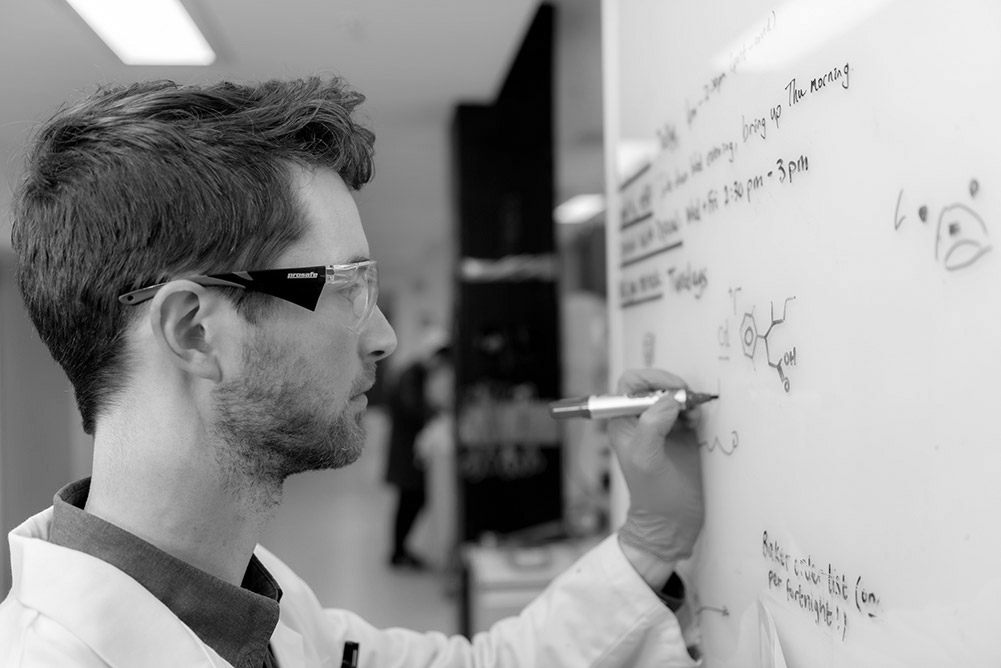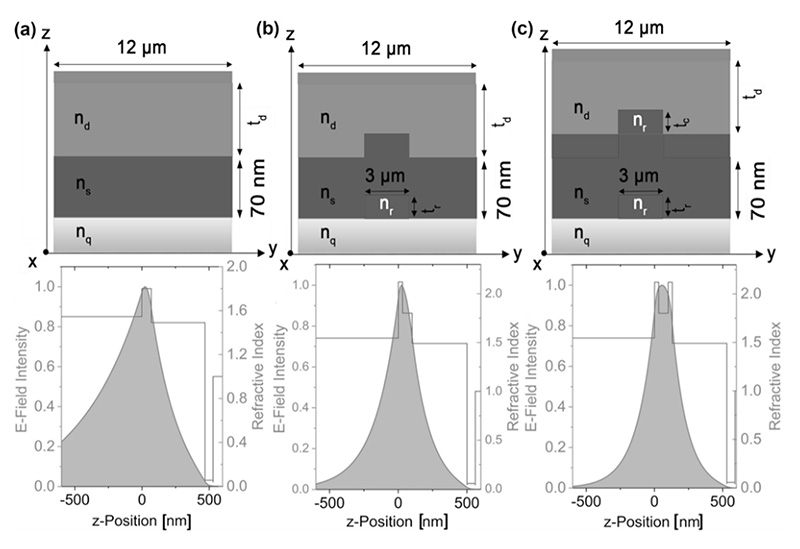Theme 3
Excitonic Systems for Security, Lighting and Sensing
Manipulation, detection and use of light through excitonic materials are key concepts that will enable a raft of future technologies.
The overarching mission of this theme is to design and create materials with properties specifically defined for target applications that are relevant to industry. The Centre has worked closely with our core partners in this theme – DSTG (Platform 3.1), RBA (Platform 3.2) and CSIRO (Platform 3.3) – and has achieved significant targets and milestones including: development of new materials for chemical sensing, fabrication of blue-emitting quantum dot light-emitting diodes, while two new materials for document securitisation have been synthesised.
A Grand Challenge goal in this theme is to build an electrically pumped organic polariton laser. Such a low threshold laser has the potential to transform commercial applications of lasers.
Platform 3.1 - Excitonic Sensors
Platform Leader: Wallace Wong
Deputy Platform Leader: Greg Barbante
The goal of this platform is to develop emerging emissive materials, robust strategies and analysis procedures for miniaturising and simplifying luminescence chemical sensors with lower economic cost than existing large laboratory instruments, higher sensitivity than ordinary paper tests and better selectivity than electrochemical detectors.
In partnership with the Defence Science and Technology Group (DST), the Centre is in a unique position to develop portable and robust chemical sensors with high sensitivity and specificity. DST is investigating technologies that can be included in such a device, with a particular focus on a photoluminescence-based response system.
Last year marked a significant shift in the work of the platform, from sensor materials development to sensor device design and testing. The work package on nanocrystal perovskite halide sensors is nearing completion. Quantum dot-polymer films have also been demonstrated as a down-shifting UV light filter.
We have developed a new device that allows the use of solution chemistry for chemical detection, greatly expanding the variety of probe materials that can be used. In addition to the detection of chemical species, an extension of the project has been devised to detect biological species.
Progress has been made towards the optimisation of the filter for catching aerosols.
People
Chief Investigators
| Name | Node |
|---|---|
| Paul Mulvaney | University of Melbourne |
| Wallace Wong | University of Melbourne |
| Jacek Jasieniak | Monash University |
Partner Investigators
| Name | Node |
|---|---|
| Greg Barbante | DST Group |
| Rebecca McCallum | DST Group |
Postdoctoral Research Fellows
| Name | Node |
|---|---|
| Nicholas Kirkwood | University of Melbourne |
Postgraduate students
| Name | Node |
|---|---|
| Na Wu | University of Melbourne |
| Ben Tadgell | University of Melbourne |
| Irina Zharinova | University of Melbourne |
| Hanchen Li | Monash University |
| Tze Cin Owyong | University of Melbourne |
| Jacob Fry | University of Melbourne |
Progress towards Project Scope
In 2021, Platform 3.1 continued to work with the chemical detection team of DST Group to develop new materials and device engineering for compact sensor devices. There are three main aspects to this collaboration:
- A quantum dot down-shifting film for integration with the excitation source of sensor devices.
- Testing of nanocrystal caesium lead halide perovskite probe for methyl bromide and sulfur mustard.
- Device engineering and testing of a compact sensor for detection of aerosols.
For the first work package, the down-shifting film has been fully characterised and is able to down-shift UV light from an LED efficiently. The only testing that remains is the in-situ experiment of the film in the sensor device.
For the nanocrystal perovskite work package, comprehensive analysis of the material has been completed and the work has been published. The focus of the nanocrystal perovskite work in 2021 has been thorough testing of this chemical probe against sulfur mustard and its simulants.
Due to strict controls, the sulfur mustard sensing work was performed at DST Group labs by Dr Genevieve Dennison, who was assisted by Ben Tadgell, the PhD student on the project.
The most significant research effort in this platform in 2021 was in the third work package on device engineering and testing of a new sensor for detection of aerosols. This work is performed by PhD student Jacob Fry who joined the Centre in 2020. This new device allows the use of solution chemistry for chemical detection which greatly expands the variety of probe materials that can be used.
Progress has been made towards the optimisation of the filter for catching aerosols. An updated version of the device includes flexibility to incorporate spectral filters for the excitation source which will enable the completion of the first work package. The latest version of the device also includes microfluidic channels for delivering analyte solutions, allowing for expanded solution chemistry sensing methods.
Along with Jacob Fry, Dr Nick Fitzgerald and Dr Greg Barbante of DST Group have been driving this aerosol sensor project. The project is also receiving assistance from Dr David Collins from Biomedical Engineering at the University of Melbourne on the design of the microfluidic component. In addition to the detection of chemical species, an extension of the project has been devised to detect biological species.

Progress update in 2021
2021 marked a significant shift in the work of the platform, from sensor materials development to sensor device design and testing. The work package on nanocrystal perovskite halide sensors is nearing completion. It has been demonstrated that these nanocrystals can detect methyl bromide, methyl iodide and sulfur mustard with high sensitivity. Quantum dot-polymer films have also been demonstrated as a down-shifting UV light filter. Both developments await their incorporation into a sensor device.
A new project was added in 2020 working on the development of a sensor device capable of aerosol detection. A PhD student, Jacob Fry, was recruited for this project. In 2021, all research effort on this project was focused on device optimisation. The latest device design allows solution handling through microfluidics and incorporation of optical filters. These features will allow the device testing of the nanocrystal perovskites and quantum dot-polymer films going forward.
Risk and Mitigation
Being an experimental platform requiring lab access, pandemic lockdowns in Sydney and Melbourne greatly hindered research progress. This particularly affected collaborative experiments that require access to more than one location. For example, the sulfur mustard detection with nanocrystal perovskites had to be performed at the DST Group laboratory. These experiments were delayed on multiple occasions but have eventually been completed. Similarly, there have been some delays to the delivery of new device designs for the aerosol sensor.
Dr Wenping Yin completed her contract with the Centre at the start of 2021. The other personnel working on the nanocrystal perovskite material are PhD students, Hanchen Li and Ben Tadgell. Both are due to complete their degrees soon. A PhD student, Na Wu, did the quantum-dot polymer down-shifter work and she is also due to complete her degree. Jacob Fry will be the only PhD student in the platform going into 2022. Amid the pandemic, with severely restricted movement, we have been unable to recruit new students to work in this platform.
While we have experienced a significant reduction in personnel, we are confident that the objectives of the platform can still be met. This is largely because the materials development work in two work packages are complete. The challenge is in recruiting personnel for new projects.
Industry Collaborations
The work in this platform is built on the relationship between the Centre and DST Group. Dr Genevieve Dennison of DST Group had been the Deputy Platform Leader and an Associate Investigator of the Centre until the first half of 2021. Since July, Dr Greg Barbante of DST Group has taken over as Deputy Platform Leader, as he is the main point of contact for the aerosol sensor. There have been discussions with the Directorate of Contamination Assessment Remediation & Management (DCARM) to develop fluorescent probes to detect chemical contaminants, but the platform lacks personnel to pursue this collaboration.
For the aerosol sensor, Dr David Collins from Biomedical Engineering at the University of Melbourne is a new collaborator on the microfluidic components of the device. Science Committee funding was obtained to support the development of the microfluidic integration to the sensor device.
Outlook to 2022
For the next year of the platform, the focus is testing of the nanocrystal perovskites and the quantum dot-polymer films in the sensor device. This work can begin as soon as the updates and testing of the new aerosol device is complete. The base function of the device is to detect fluorescein aerosols for chemical protection suit testing. We will examine the feasibility of using the device to detect chemical aerosols such as sulfur mustard using nanocrystal perovskite chemistry. We will also explore the detection of biological species by integrating our device with Loop-Mediated Isothermal Amplification (LAMP) assays.
Research Highlights in 2021
Australian scientists adapting solar energy technology to detect chemical warfare agents and pesticides
Read more...The detailed investigation into the nanocrystal caesium lead halide material led by Dr Wenping Yin was published in ACS Nano at the start of 2021. [ ACS Nano 2021, 15, 1454-1464.] This work received significant public exposure with reports on several online news channels. The interest stems from the fact that these perovskite materials are used in solar energy conversion, but our work uncovered their chemical sensing capability.
In the work package on aerosol detection, there has been several improvements to the device design. The device now includes microfluidic channels and flexibility to insert optical filters. It is anticipated that results from this work package will be ready for disclosure in the next six to 12 months.
Apart from core work packages, work is continuing on the development of fluorescent chemical sensor molecules. A turn-on fluorescent probe for albumin was reported [Chem. Asian J. 2021, 16, 1245-1252.] and a new solvatochromic dye was investigated showing performance amongst the best solvatochromic materials reported to date. [Org. Mater. 2021, 03, 103-118.]
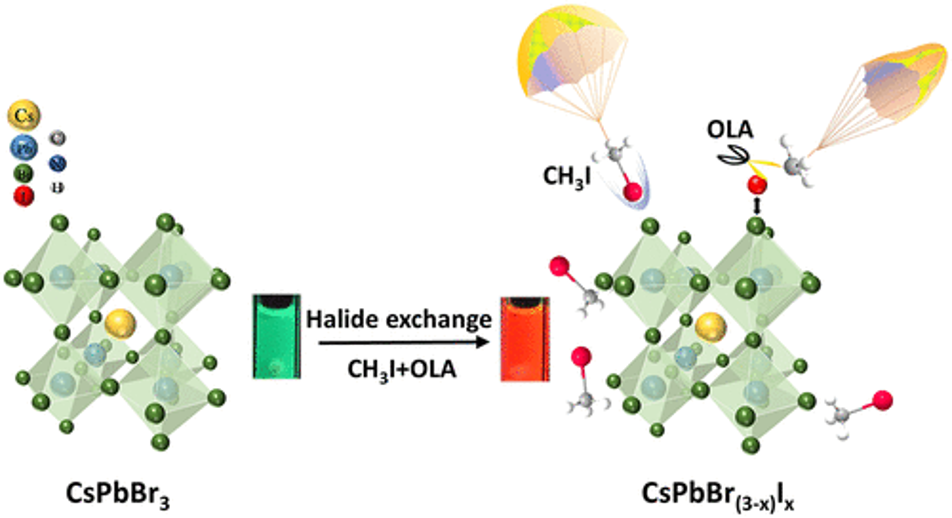
The detection of halides by nanocrystal caesium lead halide perovskites through anion exchange.
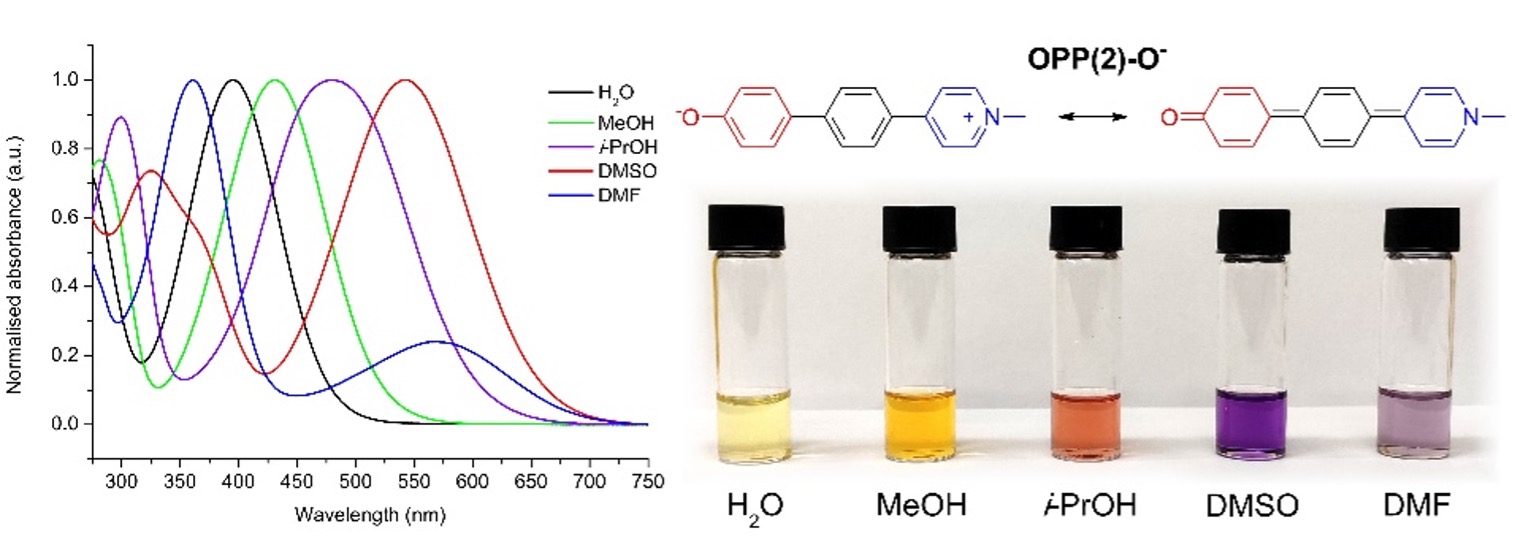
Solvatochromic donor-acceptor organic dyes with spectral variation in the visible range.
Platform 3.2 - Novel security features for the RBA
Platform Leader: Timothy James (RBA)
Deputy Platform Leader: Paul Mulvaney
Australia leads the way in the development of polymer banknote technology. With counterfeiters gaining improved access to lower cost technologies, more sophisticated forgeries are possible
To maintain confidence in the currency, development of new security features is needed. The most important security features that act as a first line of defence in identifying counterfeits are overt features. These features must be straightforward and intuitive for the public or cash handler to use in helping them identify the banknote is genuine. The security features must be durable, printable, difficult to replicate, and cost-effective.
Platform 3.2 is focused on the development of new overt optical security features for Australian polymer banknotes. The overarching goal is to produce banknote security features that are difficult to counterfeit and simple to verify. Such security features must be able to meet multiple requirements such as cost effectiveness, efficacy, durability, printability, and public safety.
Significant recent progress has been made in producing overt optical effects through the self-assembly of magnetic nanoparticles under laboratory conditions. Challenges around including magnetic inks into security inks are now being investigated.
Samples from a pilot scale trial for machine readable near infrared inks are undergoing durability and machine testing.
People
Chief Investigators
| Name | Node |
|---|---|
| Paul Mulvaney | University of Melbourne |
Partner Investigators
| Name | Node |
|---|---|
| Greg Dicinoski | RBA |
| Timothy James | RBA |
| Sani Muke | RBA |
Associate Investigators
| Name | Node |
|---|---|
| Ann Roberts | University of Melbourne |
Postdoctoral Research Fellows
| Name | Node |
|---|---|
| Nicholas Kirkwood | University of Melbourne |
Postgraduate students
| Name | Node |
|---|---|
| Dingchen Wen | University of Melbourne |
| Heyou Zhang | University of Melbourne |
| Trent Ralph | University of Melbourne |
Progress towards Project Scope
The Platform has two projects running concurrently, developing two separate banknote security feature concepts, where both magnetic and optical nanomaterials are being investigated for inclusion in banknote inks.
Project 1: Magnetic Nanoparticle Ink (MNI):
Significant progress has been made in synthesizing the magnetic nanoparticles with the desirable physical dimensions to produce colour and overt optical effects when assembled in a model solution.
The synthesis of magnetic nanoparticles and the development of a finished printing ink is ongoing, with challenges around producing highly monodisperse nanoparticles, and incorporating those nanoparticles into security inks currently being investigated.
Parallel to the synthesis research effort, work is ongoing into understanding the fundamentals behind the overt optical effects, and how best to exploit them to produce a highly overt feature in production using various optical and magnetic modelling methods.
Project 2: Machine Readable NIR Inks:
A Pilot Scale printing trial of the Near Infrared (NIR) Ink was carried out, where the IR absorbing material was able to be included into a security ink relatively easily and printed using banknote production equipment on polymer substrate.
Durability and machine testing tests are expected to be completed in the coming months, which will determine the future direction of the project.
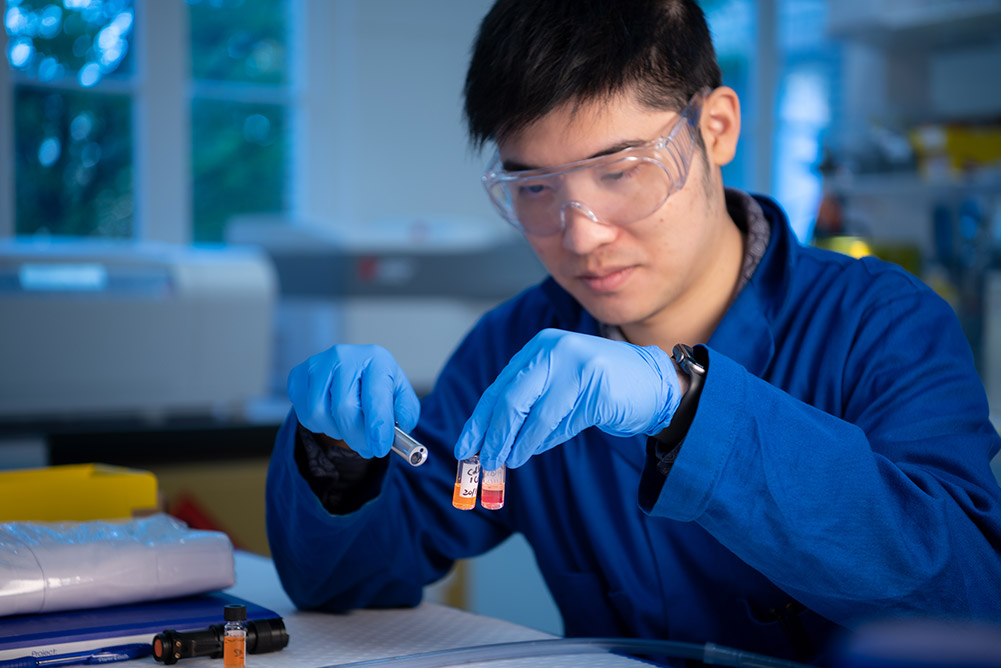
Progress update in 2021
A Research Project Agreement was executed between the University of Melbourne and the RBA for the MNI project. The Agreement enables the direct funding by the RBA of a Research Associate position to work on lab scale development of MNIs, and the partial funding of a Research Fellow to investigate the nanoparticle scale-up processes.
Progress has been made in producing overt optical effects through the self-assembly of magnetic nanoparticles under laboratory conditions. A Research Associate is now investigating inclusion of nanoparticles into security inks, and work continued on analyzing and optimizing the magnetic nanoparticles for improved visual performance.
The Pilot Scale print trail of the NIR inks with production equipment on banknote substrate was successful. Samples from the pilot scale trial are undergoing testing for durability testing and machine functionality evaluation.
Risk and Mitigation
The program initially started with five ideas. The program is stage gated, i.e. new ideas can be introduced but after an agreed time point, if progress is unsatisfactory, projects are discontinued.
This can involve a complete halt but more typically means shifting to purely scientific goals such as thesis completion or publication.
The primary risks we believe the projects have are:
- New materials may not be scalable, uneconomical for use in banknote technologies, or unable to generate the desired efficacy, durability or functionality for the project to progress to later stages.
- RBA may change research directions in response to changing international demands on currency protection and national and international counterfeiting.
- Inability to secure staff for key projects due to lack of domestic students qualified for the project or visa delays for talented overseas staff due to COVID restrictions.
Industry Collaborations

Outlook to 2022
The Platform is on target to produce:
- One new material for NIR Machine Readable Features.
- One new optical security feature (MNI Project).
There is expected to be a set of prototypes produced for the MNI project in the first half of 2022. If successful and Note Printing Australia’s production schedule permits, a pilot scale trial of the security feature will occur later in the year.
The NIR feature will undergo testing in the field, which will determine the direction of the project. If successful, a larger trial may be carried out and an IP freedom to operate legal assessment to ensure there are no impending IP issues.
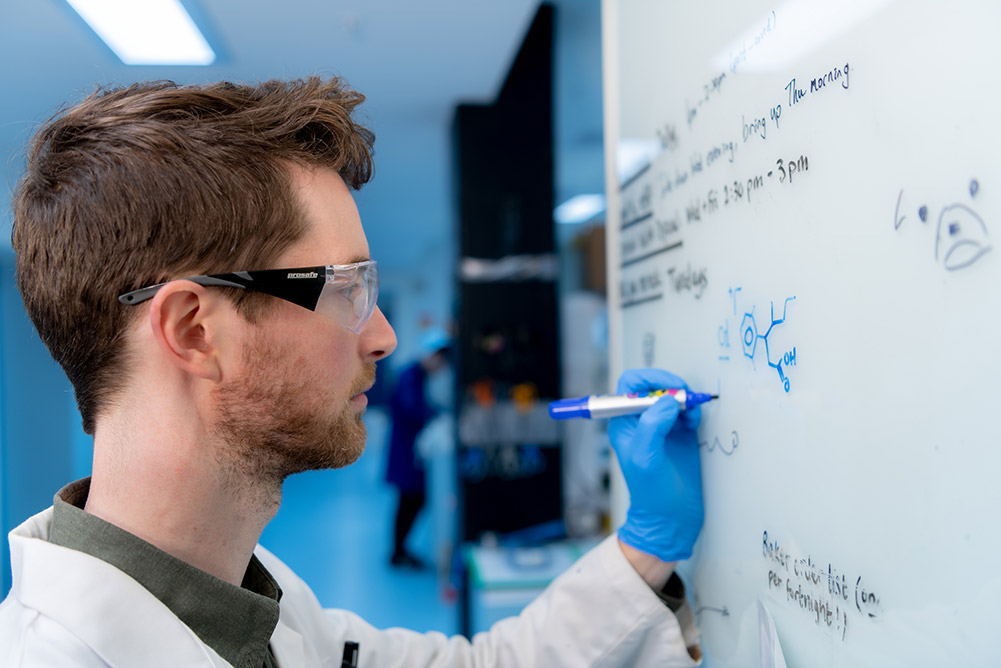
Research Highlights in 2021
Successful demonstration of proof-of-concept samples, where overt coloured optical effects were produced using magnetic nanoparticle materials in curable monomer.
A number of optical effects were demonstrated, highlighting the versatility of the materials, and indicating the potential for a number of different security feature embodiments.
A pilot scale trial was successfully carried out at Note Printing Australia on the NIR inks. Testing and examination of the trial material is underway.
Platform 3.3 - Light Emitting Devices
Platform Leader: Girish Lakhwani
Deputy Platform Leader: Anthony Chesman
This platform aims to deliver solutions for future lighting and display technologies by developing materials and devices beyond current efficiency, brightness and stability limits with spectral coverage from the ultraviolet to visible and infrared range.
These next-generation light-emitting devices (LEDs) will open up new architectures and applications, such as tunable lasers.
We employ a combined theoretical and experimental approach towards the realisation of a stable blue LED that has been challenging traditionally due to triplet losses and defect emission, and an electrically pumped polariton laser.
Among our recent achievements was the demonstration of improvements to optical confinement in organic field effect transistors using high refractive index cladding layers for electrical injection photonic lasing.
In addition to core work on LEDs and polariton lasing, positive progress continues to be made in the related areas of faraday rotators/optical isolators, polariton-assisted chemistry and plasmon-exciton states.
Our immediate priorities include developing blue perovskite-based LEDs using a back-contact electrode architecture, continuing work towards demonstrating electrically injected lasing, and exploiting strong exciton-photon coupling on various photophysical processes.
People
Chief Investigators
| Name | Node |
|---|---|
| Paul Mulvaney | University of Melbourne |
| Wallace Wong | University of Melbourne |
| Girish Lakhwani | University of Sydney |
Associate Investigators
| Name | Node |
|---|---|
| Pegah Maasoumi | Swinburne University of Technology |
| James Hutchison | University of Melbourne |
| Daniel Gomez | RMIT University |
| Ivan Kassal | University of Sydney |
| Heike Klussman | University of Kassel |
Partner Investigators
| Name | Node |
|---|---|
| Anthony Chesman | CSIRO |
Postdoctoral Research Fellows
| Name | Node |
|---|---|
| Patrick Conaghan | University of Sydney |
| William Kendrick | University of Melbourne |
| Jialu Li | University of Melbourne |
Postgraduate students
| Name | Node |
|---|---|
| Jiho Han | University of Melbourne |
| Julien Leoni | University of Sydney |
| Alison Campbell | University of Sydney |
| Nicholas Sloane | UNSW Sydney |
| Dingchen Wen | University of Melbourne |
| Claire Dawson | University of Melbourne |
| Yun Li | University of Sydney |
| Eliza Rokhsat | University of Melbourne |
| Jungwoo Ma | University of Melbourne |
| Inseong Cho | University of Sydney |
Progress towards Project Scope
This platform has two major research thrusts driven by highly collaborative activities involving two research universities, University of Sydney and University of Melbourne, and partners at CSIRO. The first is on the development of blue-emitting quantum dot (QD) LEDs and the second is towards the demonstration of an electrically injected polariton laser.
Light Emitting Diodes (LEDs)
At the start of 2020, Associate Investigator Anthony Chesman at CSIRO commenced discussions with members of Chief Investigator Udo Bach’s group (Monash University) regarding the development of a back-contact blue perovskite LED. This work would use the quasi-interdigitated back-contact electrode architecture developed by the Bach Group for perovskite solar cells and use high band gap perovskites (predominantly chloride-based analogues) as the light emitting layer. While this work was unable to directly commence due to COVID-related lab closures, the Bach group has continued to develop a variety of back-contact electrode configurations that are advantageous for perovskites, and it is anticipated this will greatly assist the fabrication of the first BC-PeLEDs.
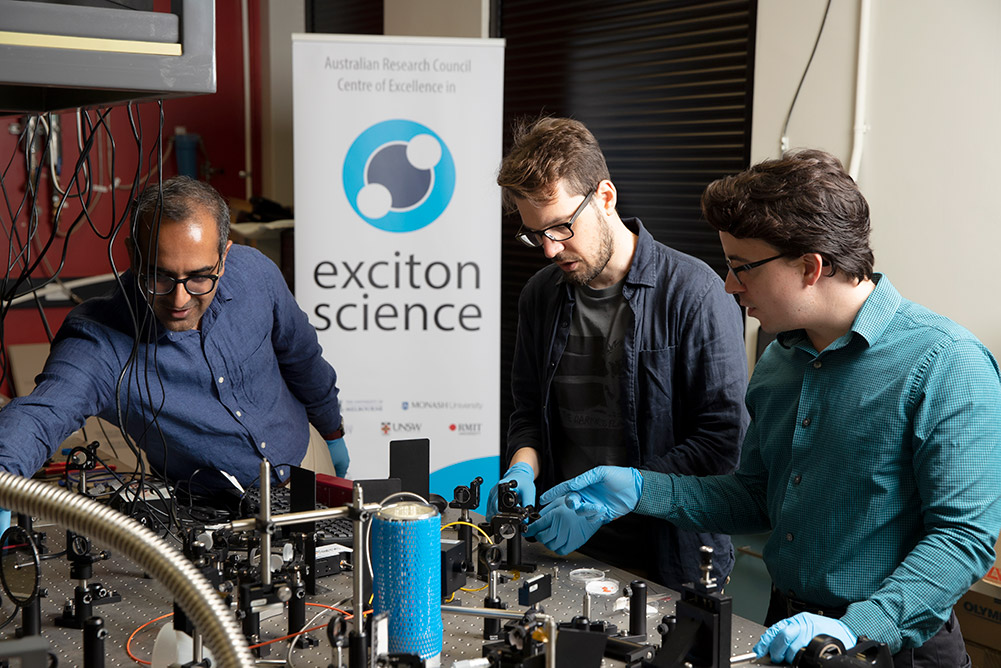
Polariton lasers
In this thrust, for the last two years the Lakhwani group has (a) identified two new dyes - perylenes (in collaboration with the Wong group) and DPPs (in collaboration with researchers from UQ) - that can show strong light-matter coupling evidenced by large Rabi splitt >150 meV (2019-20), and (b) demonstrated optically pumped polariton lasing (in collaboration with the Schmidt group) in 2020. In 2021, the Lakhwani group focused largely on identifying device geometries that can enable electrical injection.
Ambipolar organic field effect transistors (OFET) have gained considerable attention over organic light emitting diode (OLED) architectures for electrical injection photonic lasing, overcoming intrinsic issues such as poor charge-carrier mobility, exciton-polaron annihilation and losses from metallic electrodes. For example, in ambipolar OFETs, the spatial position of recombination can be shifted away from drain and source contacts, thereby decreasing the probability of exciton-polaron annihilation. To obtain low lasing thresholds, it is essential to confine light in the vicinity of excitons, i.e. the recombination zone to achieve light amplification. Using Lumerical simulations and experiments, we demonstrated improvements to optical confinement in OFETs using high refractive index cladding layers, as shown in Figure 1 below. Additionally, we show that introducing this layer does not introduce any optical losses, which may further attenuate the confined light compared to the standard structures. [1]
Due to CI Lakhwani’s growing visibility in the field of lasing, his group was invited into a new collaboration from Rongkun Zheng’s group in the School of Physics at USyd to work on halide perovskites for FETs. Together, they demonstrated epitaxially grown CsPbBr3 thin single crystals to show that top-gate/top-contact FETs exhibit high on/off ratios of over 105, an optimal hole mobility of 3.9 cm2 V–1 s–1, almost hysteresis-free operation, and high stability at room temperature. [2]
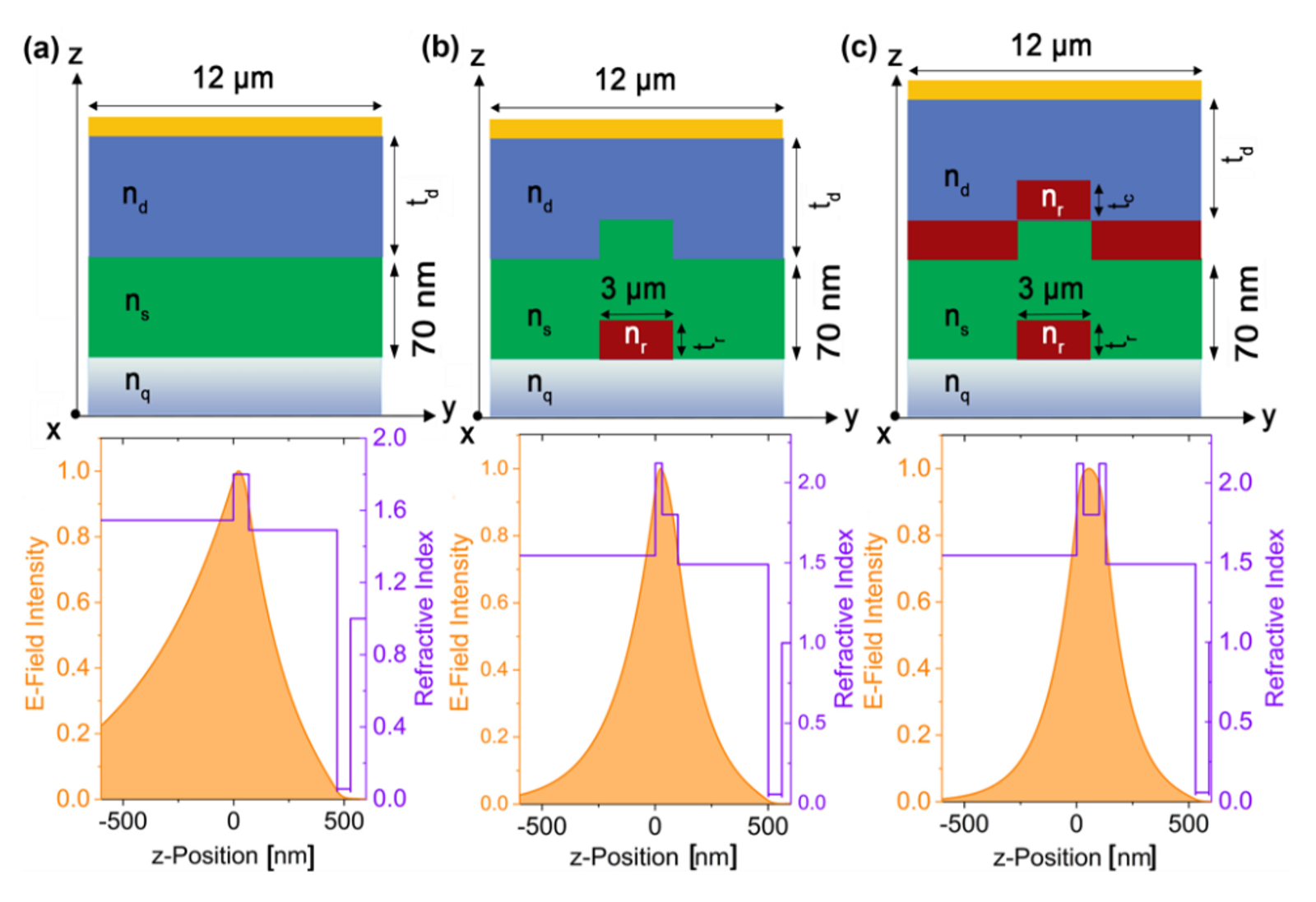
Figure 1: Schematic for (a) base thin film structure, (b) integrated-ridge waveguide and (c) cladded structure for a top-gate FET (injection contacts omitted) with their corresponding TE0 mode field intensities with refractive indices nq = 1.46, ns = 1.7, nd = 1.49, nr = 2.12. [Figure taken from ref 1]
Related activities
Faraday rotators/optical isolators
As outlined in last year’s report, we had not originally set out to study optical isolators, but as these are key components used to stablise laser cavities by blocking reflected light, CI Lakhwani began exploring different material systems in collaboration with CI Bach and AI Anita Ho-Baillie that could effectively be used both as light emitting materials for lasers and as optical isolators, i.e. show Faraday rotation. In 2020, we demonstrated the Faraday effect in lead bromide perovskite crystals with Verdet Constants on par with the industrial standard, TGG crystals. In 2021, we continued this work to show that by varying halides, the Faraday effect can be extended to cover the larger visible spectral region, especially in the blue, using chlorides. [3] Surprisingly, lead halide iodides don’t show appreciable Faraday rotation in the NIR, contrary to our calculations, indicating a potential discrepancy between the properties of thin films and single crystals.
On a separate note, CI Lakhwani also contributed to an invited News and Views article for Nature Photonics on polarisation control in perovskites, thanks to our increasing visibility in this research field. [4]
Polariton-assisted chemistry
AI James Hutchison and Prof. Hiroshi Uji-I (Hokkaido) continued their collaboration to extend past work on the vibro-polaritonic chemistry of a common cycloaddition reaction to now show selective crystallisation of metal organic framework pseudopolymorphs via vibrational strong coupling. [5]
Plasmon-exciton states
In another activity, AI Daniel Gómez and Prof Misawa (Hokkaido) showed that near perfect energy absorption by coherent light-matter states was demonstrated for a system comprised of a monolayer of gold nanoparticles in direct contact with molecular excitons, both interacting with incident light and an optical resonance supported by a Fabry-Perot cavity. [6] The cavity modifies the radiative rate of the metal nanoparticles leading to a “critical coupling condition” (wherein the energy is captured and dissipated by the system at equal rates) that manifests by an absorption of 90% of the incident light at the resonant frequencies. The study also demonstrated the potential of this scheme for generating charge-separated states that could be used in applications such as the generation of solar fuels.
Relevant publications:
- Y. Li et al “Improved optical confinement in ambipolar field-effect transistors toward electrical injection organic lasers” Appl. Phys. Lett. 119, 163303 (2021)
- T. Yang et al “Solution Epitaxy of Halide Perovskite Thin Single Crystals for Stable Transistors” ACS Appl. Mater. Interfaces 13, 37840 (2021)
- C. Stamper et al “Magnetic optical rotary dispersion and magnetic circular dichroism in methylammonium lead halide perovskites” Chirality 33, 610 (2021)
- R. Sabatini and G. Lakhwani “Achromatic polarization control in the visible” Nat. Photon. 15, 797 (2021) - News and Views
- K. Hirai et al “Selective crystallization via vibrational strong coupling” Chem. Sci.,12, 11986 (2021)
- D.E. Gómez et al “Near-Perfect absorption of light by coherent plasmon-exciton states” Nano Lett. 21, 3864 (2021)
Progress update in 2021
The project is divided into five work packages, as shown in the tube map below - Towards Flexible LEDs, Materials Discovery for Polaritons, Device Engineering, Theory of Exciton Polaritons and Device Simulations and, lastly, Industry Research. The activities have not changed scope and have been largely on track, meeting the aims and milestones of the four-year objectives.
A small number of exceptions, including on electrically injected lasers and theoretical development, are discussed in more detail below. These activities have been largely impacted by the COVID-19 pandemic for the better part of two years due to reduced mobility between USyd and CSIRO, as well as recruitment issues, and resourcing of consumables and equipment.
Towards Flexible LEDs
Milestones M1 and M2 have been met. Work is ongoing to (a) identify better blue emitters for display applications and (b) explore new device geometries such as back-contact perovskite LED.
Materials Discovery for Polaritons
Milestones M1-M4 have been met. New TADF molecules (M5) have been synthesised by Wong’s lab for lasing and light emission. These molecules will also provide opportunity to explore if reverse intersystem crossing rates can be modified in optical cavities.
Device Engineering
Milestones M1-M6 have been met. New LEFET-based device geometries using ridge cover layer demonstrate the optical confinement necessary for photonic lasting (M7). That said, achieving electrical injection and confinement in LEFETs remains a challenge and is the basis of ongoing work. Given the lack of personnel and COVID-19 lockdowns, this aspect of the project is lagging. Milestones M8 and M9 may take another couple of years.
Theory of Exciton Polaritons and Device Simulations
Milestones M1-M3 have been experimentally demonstrated and simple oscillator theory shows that while molecules and aggregates may afford Rabi splitting, aggregates are not suitable for lasing because aggregate emission (and quenching) dominates the emission from lower polariton branch. Work is ongoing to simulate optical confinement and device physics (M4-6) using Lumerical software as new device geometries and optical cavity structures are identified.
Industry Research
We had originally set milestones as a means of engaging with industry on different aspects of laser fabrication. However, to date our interactions with industry have given us the impression that their focus is more on wafer fabrication for lasers rather than laser product development.
In our work with BluGlass, M1-M3 have been largely met. We helped identify a base structure for GaN lasers and performed gain and loss on a series of GaN wafers both experimentally and through simulations.
While the work is still in progress, it is currently paused because BluGlass has prioritised other projects to mitigate the impact of COVID-19 on their business.
Risk and Mitigation
COVID-19 lockdowns in Melbourne and Sydney made it difficult to implement succession plans for outgoing personnel, and ongoing challenges in recruiting competitive international candidates due to COVID-related travel restrictions has affected research activities in this platform.
To mitigate this, an extensive targeted search for domestic candidates was carried out and two postdocs have recently been recruited with device experience, including one postdoc funded by the Centre’s roving postdoc scheme, working across USyd and CSIRO.
This increased research capacity is further strengthened by the addition of Dr William Kendrick, who recently joined the Wong group at UoM after completing his PhD at Oxford, to provide new lasing materials. For the better part of 2020 and 2021 Kendrick was unable to travel to Australia, which has impacted material synthesis.
Due to COVID restrictions, the future work outlined in last year’s Platform Review to study the impact of cavity excitonics on photophysical processes, such as singlet fission and charge dissociation and recombination in organic solar cells, could not be achieved. We aim to fulfil these objectives in 2022.
Efforts towards the development of QD-LEDs have slowed following Christian Blauth, the PhD student working in this area, completing his studies. Unfortunately, the severe disruptions of COVID-19 have continued into 2021, limiting our ability to recruit new students in this area of work.
We have continued to explore a new opportunity which leverages the expertise of other researchers in the Centre, namely the Bach group’s world-leading back-contact electrode design, to develop a novel LED architecture. Although this was under discussion in 2021, laboratory work was prevented due to site closures. Now that site access has returned it is anticipated that the first lab work in this area will commence shortly and the fabrication of a back-contact perovskite LED will be demonstrated.
On a different QLED project, Dingchen Wen (UoM) continues to work on GaN nanocrystals in an effort to solve the stability issues identified by Blauth during his PhD. We will also examine graphene as a replacement for ITO in devices.
Industry Collaborations

BluGlass Pty Ltd
BluGlass Pty Ltd work with the research groups in platform 3.2 on modal loss and gain measurements using GaN lasers.
International Participation
Due to continued COVID-19 impacts throughout 2021, initiating new collaborations has been challenging. Instead, we focused our efforts on strengthening the following partnerships:
Prof Ulrich Scherf (Wuppertal) on lasing materials including MeLPPP and a binaphthyl-based fluorene dimer. The aim is to use these materials in DFBs to demonstrate low threshold photonic lasing.
Prof Satish Patil (IISc Bangalore) and A/Prof Jyotishman Dasgupta (TIFR Mumbai) on polaritons in twisted perylene dimers. The aim is to study the impact of strong coupling on charge dissociation and recombination in perylene based solar cells.
Prof Makhsud Saidaminov (new collaboration from University of Victoria, Canada) on Faraday rotation work in different halide perovskites.
A/Prof Shih-Chun Lo and A/Prof Ebinazar Namdas (University of Queensland) to apply for Australia-Japan Foundation grant on “Fostering alliance and communications on electronics”.
Prof. Hiroshi Uji-I (Hokkaido) on polariton assisted chemistry.
Outlook to 2022
In the next two years, our key focus is on the following:
- Develop blue perovskite-based LEDs using a back-contact electrode architecture. Despite this being a common architecture, it is yet to be demonstrated for perovskites.
- Continue discovery projects into better blue-emitters for display applications.
- To continue work towards demonstrating electrically injected lasing.
- To exploit strong exciton-photon coupling on various photophysical processes, such as singlet fission, exciton photo physics in solar cells and chemical reaction kinetics.
Research Highlights in 2021
Tunnel vision: Improved optical confinement means a bright future for next-generation lasers
Read more...
